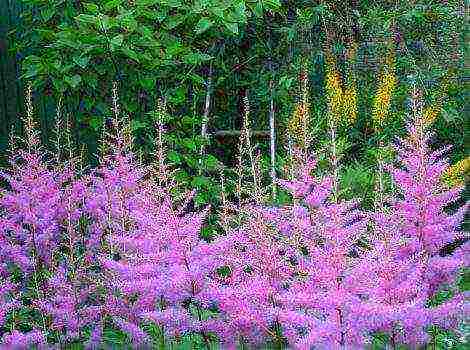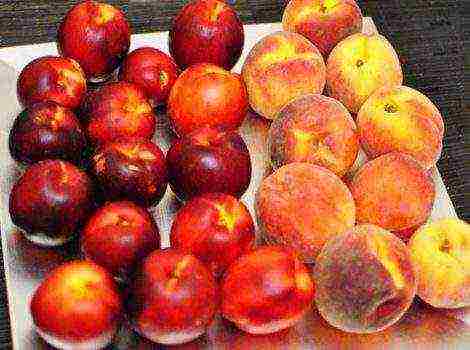Content
Do you want to feast on delicious, juicy, aromatic pears all year round? By planting trees of early, medium and late varieties on the site, you will provide yourself with ripe sweet pears for the entire summer season.
Surprisingly, very often, truly delicious pears are not very beautiful in appearance. Conversely, the fruits of most varieties, which look like they can be sent straight from the branches to the shelves, often do not differ in special taste. This article will help you understand the variety of tastes and forms.
August dew
High-yielding variety of summer ripening period. Pear trees of this variety are considered undersized and even dwarf. They tolerate frost well down to –25 ° C and are resistant to diseases. The fruits ripen juicy, sweet with a slight sour accent and white, fine-grained, delicate taste pulp. Pears are harvested still green, but after ripening they acquire a green-yellow hue with a slight blush. Fruits that have reached maturity do not fall off.
|
Entering fruiting |
Tree height (m) |
Fruit weight (g) |
Harvest |
Shelf life (days) |
|
2-3 years |
2,5-3,5 |
Mid august |
10-14 |
|
Veles
Frost-resistant pear variety. The tree is medium-sized, with a spreading crown. Fruits are symmetrical with a smooth surface, greenish-yellow with an orange tint. The pulp is creamy, semi-oily, juicy, sweet and sour. These pears are great for fresh consumption.
|
Entering fruiting |
Tree height (m) |
Fruit weight (g) |
Harvest |
Shelf life (days) |
|
For 5-7 years |
3-4 |
140-200 |
Mid september |
60-70 |
Duchess Summer (Williams)
A high-yielding dessert variety of pears. Fruits are fragrant, juicy, sweet, classic pear-shaped, light green when picked, turn yellow during ripening. Suitable for drying and preserving. The pulp is white or creamy, juicy, wine-sweet with a nutmeg aroma. This variety also has disadvantages. Pear trees do not tolerate frost and drought well. Plants require pollinating neighbors such as Forest Beauty or Lyubimitsa Klappa pears.
|
Entering fruiting |
Tree height (m) |
Fruit weight (g) |
Harvest |
Shelf life (days) |
|
For 5-6 years |
3-5 |
End of August |
45-50 |
|
Clapp's Favorite
Summer high-yielding pear variety. In the southern regions, yellow fruits with a reddish blush ripen at the end of July. The skin of the ripe fruit is smooth, the flesh is white, tender, juicy, aromatic, sweet with a sour taste. When ripe, the fruits quickly fall off and are not stored for long. It is a self-infertile variety, but in the vicinity of Duchess Letniy it will be able to fully “realize” its potential.
|
Entering fruiting |
Tree height (m) |
Fruit weight (g) |
Harvest |
Shelf life (days) |
|
7 year |
3-4 |
180-230 |
Early august |
10-15 |
Muscovite
A productive variety, perfect for growing in the middle lane. The trees are medium-sized, winter-hardy, but they are afraid of drought, due to which the yield decreases and pears fall. The fruits are wide, yellow-green in color, often with abundant rustiness. The pulp is white or creamy, coarse-grained, juicy, melting.
|
Entering fruiting |
Tree height (m) |
Fruit weight (g) |
Harvest |
Shelf life (days) |
|
For 6-7 years |
3-4 |
140-200 |
Mid september |
60-70 days |
Olivier de Serre
Winter variety of pears. The fruit looks like a flattened ball with tubercles.The view is not very presentable, but the taste is excellent. The flesh is sweet with a hint of almonds, very juicy, but quite dense. The fruits are ideal both for fresh consumption and for storage, transportation, conservation.
|
Entering fruiting |
Tree height (m) |
Fruit weight (g) |
Harvest |
Shelf life (days) |
|
For 6-7 years |
3-4 |
Early October |
140-160 |
|
Simply Maria
High-yielding winter-hardy pear variety. The tree is medium-sized. The fruits are pear-shaped, green-yellow in color with a slight pink blush. The skin is thin and dry, the pulp is yellowish-white, oily, fine-grained, sweet and sour with a weak aroma, very tasty. The variety is resistant to a complex of diseases.
| Entering fruiting | Tree height (m) | Fruit weight (g) | Harvest | Shelf life (days) |
| 3 year | 2-3 | 200 | October | 90-100 |
Every gardener dreams of growing a good harvest of delicious pears on his site. Using the information from our article, it will not be so difficult to do this.
Russia is a huge country with a wide variety of climatic zones. This feature complicates the procedure for growing fruit crops in some regions (for example, in the Urals, Siberia, etc.). Problems with pear cultivation are also encountered in the middle Volga region. Below are the varieties of pears for the middle zone of the country.
Summer varieties
Gardeners looking for an early harvest prefer to grow summer pear varieties. Their main distinguishing feature is that the fruits are ready for consumption at the end of summer, as well as short storage of the harvest. Therefore, immediately after harvest, it should be used for a variety of conservation.

In the middle zone of the country, only certain varieties can be planted. For example, Irista pear has proven itself well here. However, not only she can boast of a good harvest in such climatic conditions. Consider the most popular summer varieties among gardeners.
Chizhovskaya
The most popular type. Pear-shaped fruits are formed on the trees, which weigh about 140 g. They have a green skin with a pronounced yellow tint and white flesh. The pears are soft in structure, they are distinguished by sweet with sourness, but refreshing taste. It is characterized by early maturity and high winter hardiness.
It is worth noting that the older the tree becomes, the smaller the fruit it gives.
Lada
This is a "classic of the genre". Also a very popular variety. Early ripening variety. Appeared as a result of crossing the varieties Olga and Forest Beauty.
The tree is medium in height. Forms a crown in the shape of a pyramid. Fruiting begins at the age of three to four. The fruits have a beautiful appearance and weigh about 100 g. Their shape is conical. It is characterized by a pronounced aroma and sweet taste. Therefore, we can say that these are the most delicious pears. Fruits with a thin skin and yellowish color.

The following features are characteristic of Lada:
- cold resistance;
- partial self-fertility;
- the yield is regular and abundant;
- good immunity (especially to scab).
With proper care, approximately 50 kg of the crop is harvested from one tree.
Bessemyanka
The tree is medium-sized with a thin, wide-pyramidal crown. It tolerates negative temperatures well, but has poor resistance to scab.
This pear variety resembles apples in its fruits. They weigh about 70 g. The peel is greenish-yellow. They are characterized by a pink blush. The skin is rough. Small bumps are felt on it. Yellow-white pulp, characterized by juiciness and tenderness. The structure of the pulp is granular. They do not taste very sweet.
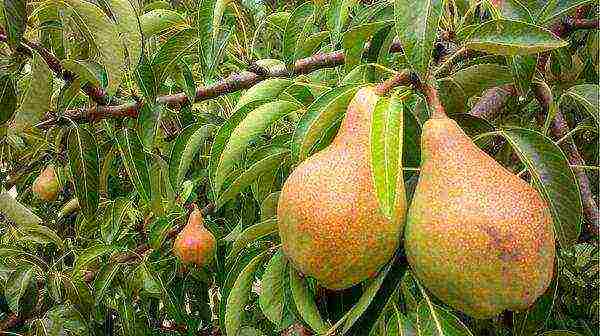
One tree can produce a high yield. After harvesting, the fruits are stored for only 10 days.
Skorospelka from Michurinsk
The tree is distinguished by its medium height and medium thickened crown. Fruiting usually occurs in the 5th year after planting the seedling and is characterized by early maturity.
The ripe fruits are removed at the end of July.The pears are medium in size and weigh about 90 g. In shape, they resemble an egg. When ripe, their skin turns yellow. Juicy and tasty pulp. Trees are characterized by resistance to low temperatures and scab.
August dew
This variety forms low-growing trees with a sparse but spreading crown. The plant has good immunity and is able to effectively resist diseases. Its fruits are short pear-shaped and weigh about 140 g. Color is greenish-yellow. The tree forms delicious pears with juicy pulp. It is characterized by a light aroma and a sweet and sour taste.
Allegro
The ripe fruits are removed from the trees already in early August. On average, pears weigh about 140 g. They are slightly elongated. The rind is greenish-yellow. A reddish tint is common. They taste sweet and have a distinct aroma. The pulp is very tender.
These are the most popular summer ripening varieties. They are able to bear fruit well with proper care in central Russia.
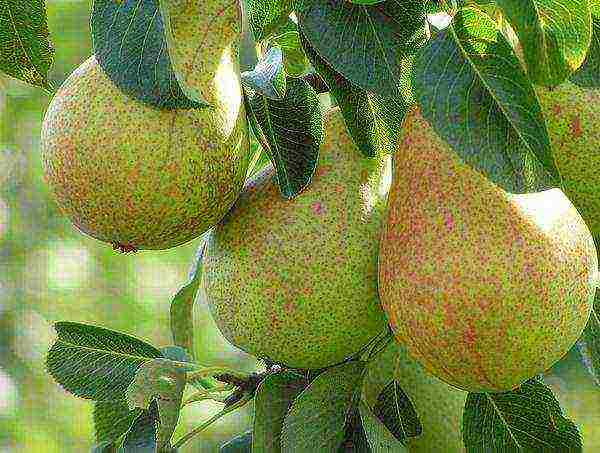
Autumn varieties
All autumn pear varieties have a much longer shelf life than summer varieties. At the same time, the fruits during storage do not lose their marketability and taste. However, you shouldn't even think about harvesting earlier. The average fruiting period for such trees is about 1–1.5 months. Therefore, it is best to plant several varieties in your garden at once.
Grades G-2 and G-3
G-2 is a late variety of autumn varieties. Its fruits are pear-shaped, with a bumpy surface. They weigh on average about 200 g. Their skin is green, but with a rusty blush. It tastes sweet and smells good.
The description of the G-3 differs markedly from the G-2. These pears weigh almost twice as much - about 400 g. G-3 forms fruits of the usual shape with a pronounced yellow color. They are delicious and have a pleasant aroma.
Rogneda
These pear trees are early maturing varieties. It is worth noting that some gardeners classify this species not as autumn, but as late summer species.
The tree is tall, but does not grow more than 10 m in height. The crown is round. Pears weighing 120 g are formed on the trees. Their skin is yellowish. There is a carmine blush. Pears are distinguished by their excellent taste and nutmeg aroma. The fruits are stored for about 3 months. One tree gives up to 90 kg of harvest.
The positive aspects of growing Rogneda include high winter hardiness, resistance to rot and scab. The downside here is the frequency of fruiting.
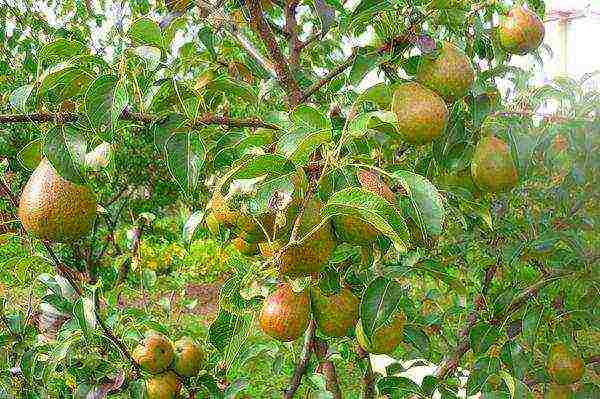
Marble
The trees are medium in height. Crown in the form of a pyramid. Fruits of standard and regular shape. The color is greenish with yellowness. Pears are sweet in taste. Their flesh literally melts in your mouth. The aroma is practically absent. The fruits are stored for a couple of months.
In order for the plantations to give good yields, they must be watered abundantly. Otherwise, the fruits will crumble. The variety resists scab well.
Muscovite
Included in the list of winter-hardy varieties. Fruiting occurs with medium-sized pears. Their usual weight is 120 g. The usual color is yellow-green. The pulp is sweet, with sourness. Has a slight aroma.
The variety is characterized by good immunity, early maturity, as well as the versatility of using the fruit.
Otradnenskaya
Otradnenskaya was obtained by crossing the Forest Beauty and Themes.
The variety is ranked among the partially self-pollinated varieties. However, for a more abundant harvest, you need to plant several pollinators nearby. It is also frost-resistant and has excellent resistance. On the trees during the fruiting period, pears weighing about 130 g ripen. They have excellent taste, but are devoid of aroma. The variety itself is distinguished by regular fruiting. The fruits can be stored for quite a long time (up to 4 months).
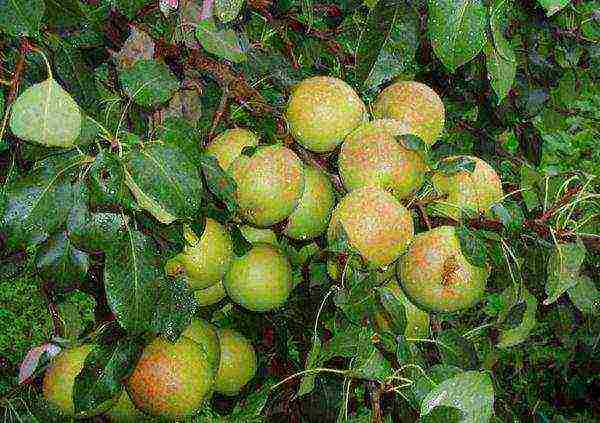
Veles
For a crop to appear after planting the seedlings, it should take about 6-7 years. But then regular fruiting is noted. On average, the fruits weigh about 150 g.Pears have a creamy flesh that tastes sweet but sour. They keep well in the refrigerator.
These are the best autumn varieties. Each pear described above is suitable for central Russia. But which variety is better to choose, each gardener decides for himself. Indeed, among them there are both self-fertile and other varieties (early and late, tall or dwarf, etc.).
Winter
Winter varieties produce ripe crops around September / October. If necessary, their fruits can be stored until the end of winter. These pears are characterized by a rich taste. Moreover, they are excellent for various types of preservation.
May Day
The trees have a compact crown. Harvesting takes place in October. You can even shoot green fruits. During storage, they will reach the required condition and turn yellow. They are stored for about 200 days. The pears have a standard shape. There is a waxy coating on the skin. The pulp is usually creamy. Has a pronounced taste and aroma. The variety is well resistant to fungal diseases and low temperatures.
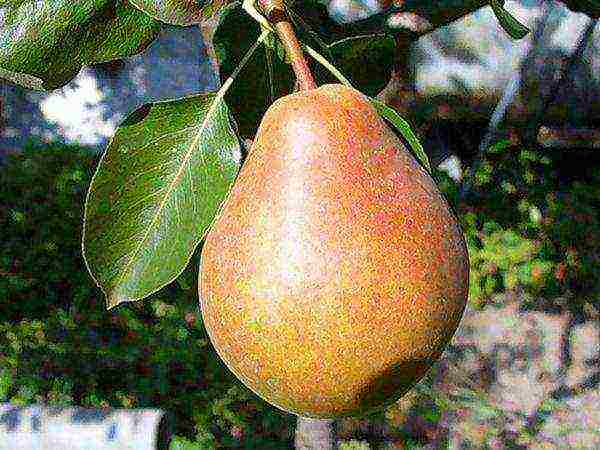
Belarusian Late
Plants form a rounded crown. The variety is characterized by good frost resistance and high yield.
Pears weigh about 120 g. They are green with an indistinct yellow tint. There is a slight blush. Juicy and grainy white flesh. It tastes sweet and sour. The fruits can be stored until February.
Nika
This variety has a very high yield. In this case, fruiting occurs at 4–5 years. Fruits are large - 200 g. Common form. The peel is yellow with a slight blush. And the pulp is creamy, rather oily and juicy. It tastes very good and smells good.
Rossoshan late
Good yield, but irregular. Rounded yellow fruits with a pronounced blush ripen on the trees. They are delicious and also look aesthetically pleasing. The pulp is fragrant and juicy.
Cuttings of this variety take root well in a new place. They can also be used for vaccinations.
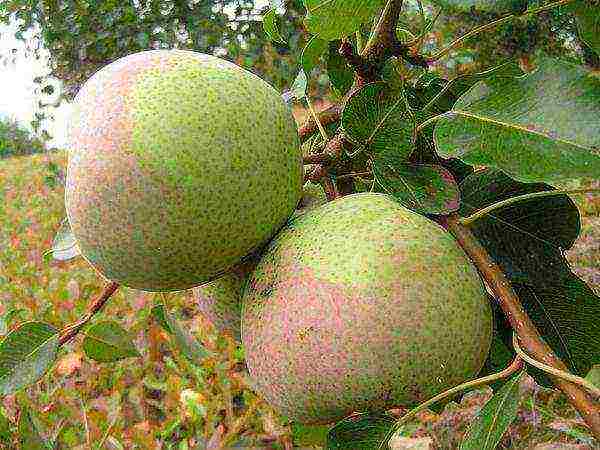
Hera
This variety also has a high yield. The trees are not very tall. They form a compact crown. The pears are large and weigh about 250 g. Semi-oily pulp. It tastes sweet, but there is sourness.
Miracle woman
Trees of this species have excellent immunity, so they rarely get sick (especially with fungal ailments). Crohn has a pyramidal shape. Most often, trees grow up to 3 m in height. The pears are quite large. Their weight fluctuates within 200 g. The pulp is sweet and sour in taste. The fruits are harvested in September.
The miracle tolerates frost well, while giving a bountiful harvest. Fruiting usually begins in the 4th year after planting.
Above, the best varieties of pears were considered, specially bred for central Russia. They all have one thing in common - they can only be grown in a zone that is not easy from the point of view of climatic conditions. However, it should be remembered that all the varieties listed above have their own characteristics - both in terms of yield and care. Therefore, before choosing a particular variety, it is necessary to study in detail all its advantages and disadvantages.
Video "Where is it better to plant a pear"
In this video, you will learn about the best places to plant a pear for high yields.
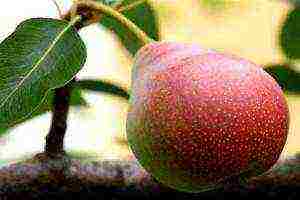
Pear is a fruit tree, quite durable (some varieties have been growing for 200 years). In terms of popularity and its massiveness, it is second only to apple trees. It blooms with white and pink flowers.
Most of the pear varieties are self-fertile, in other words, trees cannot pollinate on their own, they need trees of other varieties and pollinating insects for this.
It is for this reason that it is always necessary to plant a tree with a different type of fruit or a different variety next to pears. The plant is very light-requiring.
Ripe fruits can be very large - 300 gr., And very small - about 25 gr., Color from green to yellow, with or without blush.Many varieties of pears bring a large harvest every two years, and only from the age of seven.
In order for the harvest to be good, it is necessary to plant different varieties and at some distance from each other. To choose the best options for seedlings, you need to know their varietal characteristics. There are autumn, summer and winter varieties of pears, depending on the time of fruiting.
We will consider the most delicious and popular varieties among gardeners in this article.
Honey variety

Pear variety Honey
The tree grows only in warm areas. It grows small and compact, thanks to this size, you can save space in the garden, and plant a few more trees of other varieties.
Despite the fact that the tree is a small crop, it brings abundant, and begins to give birth early already in the third or fifth year after planting. Considered partially self-fertile.
By the time of harvesting - the fruits ripen in late autumn. The fruits are harvested around the end of September, and the harvesting period coincides with the period of consumption.
The fruits keep very well, and you can transport them without worrying that they will be damaged. Honey pear is resistant to various fungal diseases and winter hardy.
Ripe fruits:
- large, in weight reach from 300 to 500 grams;
- unequal in shape, surface with tubercles;
- the skin is thin and dry;
- the color is greenish-yellow;
- the surface is covered with small dots that look like rust;
- the pulp is oily, insanely juicy, pears are very aromatic;
- the taste is sweet and tender.
This variety is perfect for the most demanding housewives. Such fragrant and tasty pears are rarely found even in a good store. At the same time, the variety is not demanding on growing conditions and place of growth.
Advice to hostesses: Honey pear variety is perfect for making various desserts, compotes, jams and preserves.
It will stay in the refrigerator until winter, and in the New Year it will look great at the festive table.
Dessert variety
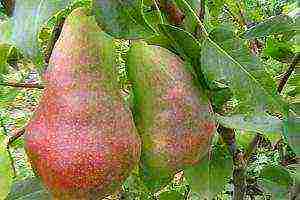
Dessert pear variety
This pear ripens in autumn. It is not too early to bloom, and not too late. The variety is winter-hardy and does not suffer from fungal diseases.
The first bountiful harvest ripens in the fourth year. The average yield is about 70 kg per tree.
The weight of the fruits is on average 160-220 grams, the shape resembles apples, the color is yellow-green, and at the time of consumption is light gold.
The dessert pear is strewn with small blotches of green and brown. This variety has excellent taste characteristics:
- juicy;
- sweet;
- pulp color - cream;
- melting;
- no grit (no sandy taste).
The variety is very transportable and has a good yield.
Variety Summer Duchess
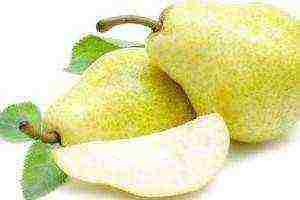
Pear variety Duchess
This is probably one of the best known and best pear varieties. In fact, it has many advantages over other varieties, both flavoring and growing.
The tree is medium-sized, with a dense and branched crown. Very beautiful inflorescences, bloom for a long time, which makes this tree a decorative decoration of the garden. The variety is self-fertile.
Unfortunately, it is not very frost-resistant. The first crop brings in six years after planting the seedling, but the harvest is abundant. The fruits have a great description:
- the color of the fruit is light green, at the time of consumption it is bright yellow, even sometimes orange;
- the taste is delicate, juicy and sweet;
- the flesh is white or creamy, soft;
- thin skin;
- the aroma of the Duchess fruit has a specific bouquet inherent in nutmeg;
- oblong fruits in shape;
- weight reaches 200 grams.
Take note: Duchesse pears produce excellent light wine and delicious marmalade.
This is one of the earliest pears. The only drawback is that the fruits are not stored for long, only about two and a half weeks.
Variety Tavricheskaya
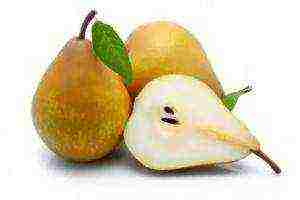
Pear variety Tavricheskaya
The flowering period is medium-late, the ripening period is winter-late (they are removed in September, the fruits must be consumed in February). The variety also needs pollinators.
The pear is unpretentious to the soil.After four years, you can harvest. The fruits are very large from 250 to 300 grams, sometimes reaching a maximum of 600 grams.
Tavricheskaya pear is very tasty, juicy, sweet with a slight sourness, the flesh is creamy in color. Fruits are yellow in color, with a slightly rough surface and small, barely noticeable brown dots.

Perhaps you will be interested in the article about
pear variety Lada
.
You can read about the unusual fruit of Pepino's melon pear
here
.
All varieties are very good in terms of taste, maturity and description. Each variety has its pluses and minuses, while some minuses are difficult to name them.
Many varieties bring a crop only once every two years, but at the same time they still bloom, thereby helping to pollinate neighboring trees, and their color is very beautiful - they carry the function of decoration in the garden.
Advice for gardeners: The most correct solution is to plant several varieties of pears with different ripening periods, so that sweet and juicy pears are on your table during all warm months.
Watch the following video about one of the autumn pear varieties - Noyabrskaya:
Rate the article
(
estimates, average:
out of 5)
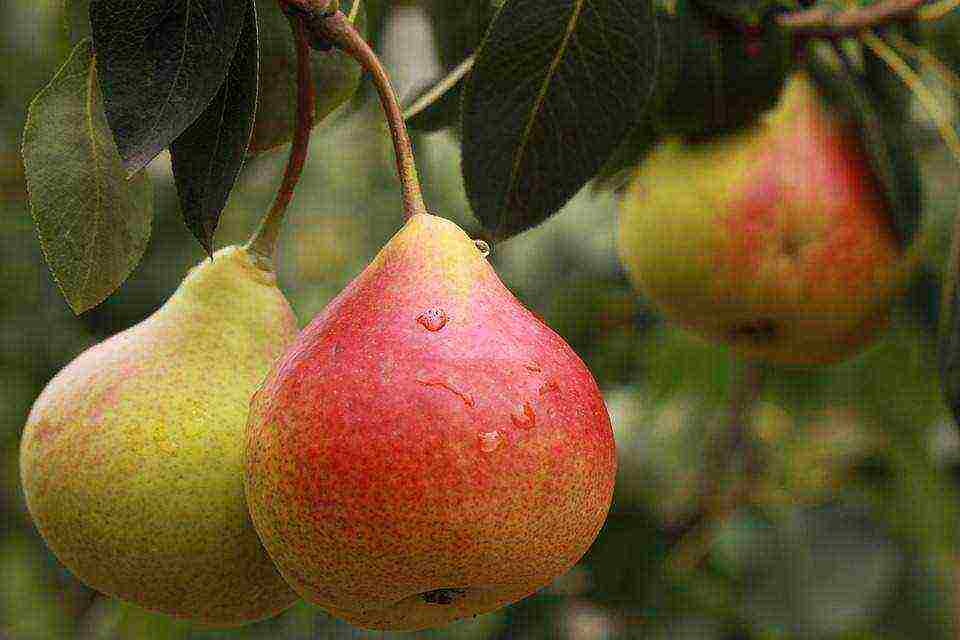
When choosing a variety, the main attention is paid to winter hardiness, and if the pear is acclimatized in your region, it means that it tolerates your winters perfectly and you can safely buy seedlings.
Further, when selecting a variety, the early maturity and yield of the variety are usually considered, well, the taste of the selected variety is of no small importance.
We offer you a selection, by looking through which you can easily find a variety suitable for your region. All these varieties are included in the State Register of Breeding Achievements of the Russian Federation in the central region.
Pear varieties for the Moscow region
These fruit-bearing trees are suitable for growing in central Russia, for the regions of Bryansk, Vladimir, Ivanovo, Kaluga, Kostroma, Oryol, Ryazan, Smolensk, Tver, Tula, Yaroslavl.
Summer pear varieties

Pear Bryansk beauty: description, reviews, photos
Late summer variety of pears. The tree is medium-sized, medium-growing. The crown is round, of medium density. Shoots are located compactly, the ends are directed upward, rounded, brownish-brown, geniculate, glabrous. Leaves are medium, elongated, short-pointed, dark green, shiny, smooth.
Fruits are large, weighing 205 grams, one-dimensional, elongated pear-shaped, regular in shape. At the stage of maturity, the color is golden yellow, integumentary - in the form of a light tan. Subcutaneous points are small, gray, few of them. The pulp is creamy, medium density, tender, oily, very juicy. The taste is sweet with a faint aroma. Tasting taste score of 4.8 points.
The variety Bryanskaya krasavitsa enters fruiting in the fifth year.
Pear Lada: photos, reviews
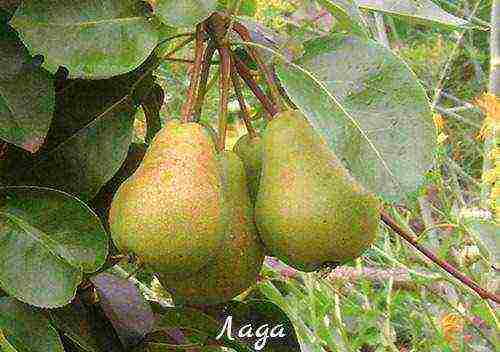
Variety of early summer consumption period. Winter hardiness is high. The variety is scab resistant. It has a high yield, fast-growing, versatile.
Characteristics of the variety
The tree is medium-sized. The crown is conical, dense. Fruits are medium in size, weighing 100-120 grams, wide pear-shaped, wide ribbed. The main color of the skin is light yellow, the subcutaneous points are small, hardly noticeable, the integumentary point is bright red, occupies less than half of the surface of the fetus. The funnel is absent, there is a small influx at the place of attachment of the peduncle. The saucer is narrow, shallow, lumpy. The peduncle is of medium length, thick, slightly curved. The pulp is yellowish-white, tender, juicy, fine-grained, sweet and sour, very aromatic, of good taste. On state variety testing since 1980. Included in the state register in 1993.
Obtained by crossing the varieties Olga and Lesnaya Krasavitsa.
Pear Cathedral: characteristics of the variety, photo
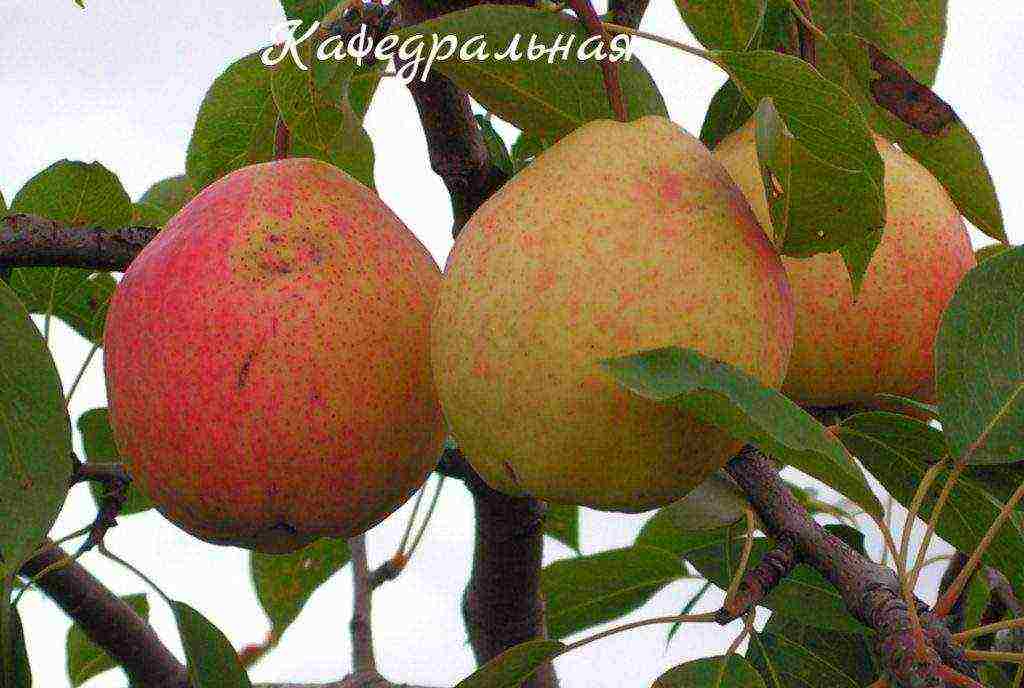
This summer pear variety was included in the State Register for the Central Region in 2001. Medium-sized tree with a conical crown. The leaves are large and medium, oval, light green with coarse nerve.
Fruits are pear-shaped, lumpy, weighing 100-110 grams, yellowish-greenish at the stage of maturity, with a faint blurred red blush. Subcutaneous points are invisible. Pear pulp is white, semi-oily, fine-grained, juicy, sweet and sour taste.
Yield 136.5 centners / ha. Removable ripeness of fruits occurs in the second half of August. The fruits are stored for 10-12 days.
Pear Severyanka: description, photo, yield
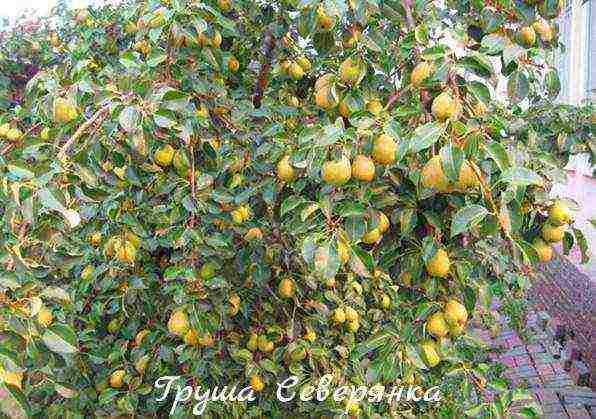
An early summer variety of the Michurin All-Russian Research Institute of Genetics and Breeding of Fruit Plants. Bred through hybridization of 2 varieties - Koperechka Michurinskaya No. 12 (Ussuriyskaya pear x Bere Ligel) x Favorite klappa.
Since 1965, the Severyanka pear variety has been zoned in a number of regions of the Volga-Vyatka, Middle Volga, Ural, West Siberian, East Siberian and Far Eastern regions. But it was most widespread in Bashkiria, Chelyabinsk, Kurgan and Kostanay regions.
The trees are of medium size and growth rates are quite fast. Shoot-forming ability is high. Crohn medium thickened, broadly pyramidal, almost round. The variety has a mixed type of fruiting.
The fruits of the Severyanka pear are not uniform in size, the average weight of the fruit is 80-85 grams, the maximum weight does not exceed 120 grams. The shape of the fruit is truncated-conical. During the period of removable ripeness, the main color of the fruit is greenish-yellow, the integumentary color occupies less than half of the pear's surface in the form of a weak blurred tan. During the period of consumption, the main color becomes more yellow with a slight green, and the integumentary color takes the form of a dull pink blush. The skin on the fruit is dull, rather thick and firm, but not too rough. There are few seeds in the fruits, they are large, dark brown in color. Creamy pulp, medium density, normal taste - crispy, juicy, slightly aromatic, sour-sweet, impatient. Pears are universal for their intended purpose.
The period of removable ripeness of Severyanka falls at the end of the first decade of August. The consumption period lasts up to 2 weeks (if the crop is stored in a cellar), after which the pulp begins to turn brown. If you eat the fruits a little earlier (5-7 days before full ripeness), then the terms of consumption of fresh pears can be extended to two months when stored in the refrigerator. It is also worth noting that although the fruits are very firmly held on the trees, when fully ripe, they completely crumble in 2-3 days. In this regard, it is also recommended to eat fruits slightly ahead of time, 3-5 days earlier.
Pear Severyanka belongs to the early-fruiting and high-yielding varieties. The first crop can be harvested as early as 3-4 years after planting, after which the yield increases rapidly. A tree at the age of 6-7 years gives up to 20 kg of fruits. With proper care and watering, the average yield of an adult tree reaches 60 kg, and in especially favorable years - 110 kg of fruits from one tree.
Pear August dew: photo, description
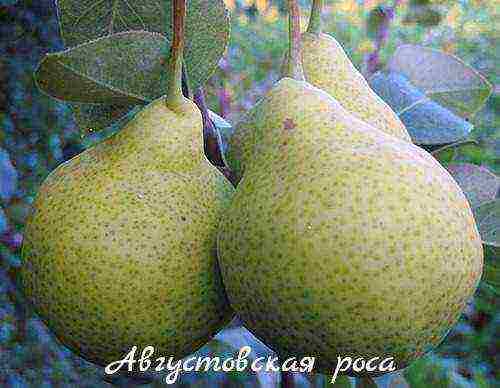
A popular summer pear variety, bred by crossing the Tenderness variety with the Australian Triumph Pakgama variety. Since 2002, the variety has been zoned in the Central Black Earth Region.
Trees up to 3 meters high are characterized by rapid growth rates. Crohn medium thickened, slightly drooping shape. Leaves are medium in size, oblong-ovoid, serrated at the edges, short-pointed at the ends, colored dark green.
Pear fruits August dew are medium in size, average weight 120-150 grams, one-dimensional, aligned, short-pear-shaped. During the period of removable maturity, the fruits have a green color and are devoid of integumentary color. During the consumer period, the main color becomes greenish-yellow, a cover color appears - in the form of a very weak blush on an insignificant part of the fruit. The skin is smooth, dull, with numerous subcutaneous punctures.The pulp is white, fine-grained, tender, melting, very juicy, harmonious sour-sweet taste. According to a 5-point tasting scale, the taste of the August dew pear is estimated at 4.6 points.
The harvest time is in mid-September. Ripe fruits are firmly held on the branches. In a cool place, the shelf life does not exceed, as a rule, 2 weeks. In the refrigerator, pears can retain their taste and freshness for up to 3 months.
The early maturity of the August dew variety is high, the trees bear fruit regularly, starting from the 3-4th year after planting. Highly productive variety. Already in the 4th year after planting, up to 15 kg of fruits can be harvested from one tree. In the period of full fruiting, the yield reaches 200 c / ha.
The level of winter hardiness and drought resistance of this pear is high. Trees are resistant to major diseases and pests, leaves and fruits are not affected by scab. The variety is unpretentious in care.
Pear Favorite Klapp: description, photo
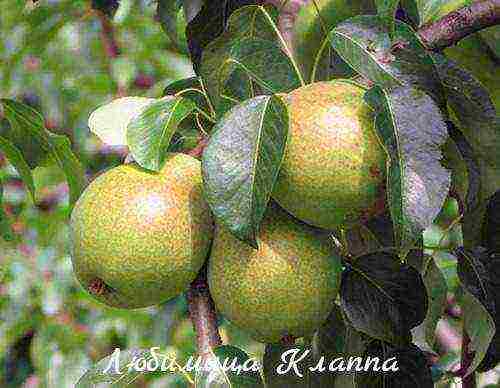
Pear variety of American selection. Other names - Favorite, Favorite Clapp. The variety is recognized as one of the best summer pear varieties, as it is ideal for production, home and farm gardening.
Trees are vigorous. At a young age, they are distinguished by rapid growth rates and form a thin pyramidal crown. With age, the crown becomes sparse, slightly "weeping" (with hanging branches) and acquires a wide-rounded shape. The average life span of this pear tree is up to 70 years.
Pear fruits Klapp's favorite large size, average weight about 200 grams. The shape of the fruit is short pear-shaped, with a large expansion towards the apex. The skin on the surface is delicate, smooth, slightly bumpy. According to the main color, the fruits are yellowish-green, when fully ripe they are yellow, the integumentary color is noticeable on the illuminated side of the fruit in the form of a bright carmine blush. The subcutaneous points are small, numerous, and hardly noticeable. Rarely, a slight rustiness may be present on the fruits - at the base of the apex in the form of small specks. The pulp is white, very juicy, tender, melting, with a light aroma, very good sour-sweet taste.
The purpose of the fruits is universal - due to their excellent taste and beautiful appearance, they are used mainly fresh, but are also suitable for canning, drying, etc.
Removable ripeness of fruits - in the middle of August.
The early maturation of the Lyubimitsa Klappa variety is low: the fruiting period begins in trees usually 7 - 8 years after planting in the garden.
Pear Marble: yield, photos, reviews
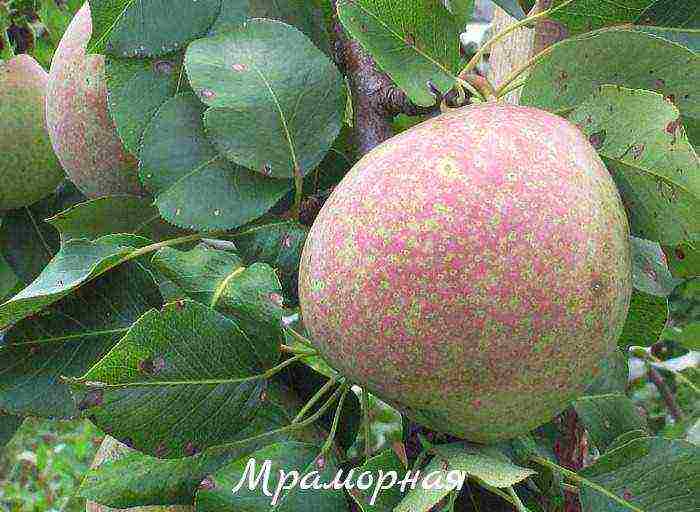
Summer, fruitful, dessert pear variety. Winter hardiness is above average. Relatively resistant to scab. The early maturity is above average.
The tree is medium-sized, with a broad-pyramidal crown of medium density.
Fruits are medium-sized, weighing 120-160 grams, round-conical, smooth. The skin is greenish-yellow with noticeable rusted subcutaneous punctures. The cover color is brown-red, blurred with strokes. The funnel is of medium depth, narrow with an influx in the area of the stalk attachment, slightly corroded. The saucer is small, wide, slightly ribbed. The peduncle is of medium length, thick, curved. The pulp is white or creamy, tender, coarse-grained, very juicy, melting, sweet, of excellent taste. The Marble pear variety was included in the state register in 1965.
The variety was obtained in 1938 by crossing Bere winter Michurina x Lesnaya krasavitsa.
Pear Chizhovskaya: variety description

The variety is fast-growing, late summer consumption with high winter hardiness, high productivity and scab resistance. Universal. The crown is oval, of medium density.
Fruits are medium in size or below average, weighing 100-120 grams, elongated, pear-shaped, elongated. The surface of the skin is smooth, matte, dry. The main color is yellowish-green with noticeable green small subcutaneous dots, the integumentary color is absent or very weak, reddish.The funnel is narrow, of medium depth, smooth. The saucer is small, narrow, smooth. The peduncle is short, of medium thickness, straight or slightly curved. The pulp is dense, juicy, semi-oily, sour-sweet, very good taste.
The Chizhovskaya pear variety was included in the state register in 1993.
Obtained by crossing the varieties Olga and Lesnaya Krasavitsa.
Pear Rogneda: variety description, reviews, photos

Late summer pear variety. A tree of medium vigor with a broad-pyramidal dense but compact crown.
Fruits are round, smooth, shiny, with an average weight of 125 grams. When ripe, the color is light yellow, integumentary is absent or appears on individual fruits in the form of a faint blurred red blush. The pulp is beige-white, medium density, juicy, slightly oily, good sweet taste with nutmeg flavor and aroma. Taste 4.1-4.2 points. Fruits reach removable maturity in the second or third decade of August. The period of fruit consumption is late August - early September.
Average yield 140.5 c / ha.
The Rogneda pear variety was included in the State Register of the Russian Federation in 2001.
Pear Prominent: photo, description of the variety

Summer pear variety with high winter hardiness. The tree is medium-sized with a narrow-pyramidal crown. Shoots curved, rounded, brown, glabrous. The leaves are oblong, green, smooth.
Fruits with an average weight of 120 grams, elongated pear-shaped, tuberous. The peduncle is short, oblique. The funnel is shallow. The color is greenish-yellow with a slight tan. Subcutaneous dots are gray, hardly noticeable. The pulp is white, tender, juicy. The taste is 4.4 points.
The average yield over the years of testing was 97 c / ha.
The Vidnaya pear variety is included in the State Register of the Russian Federation and approved for cultivation in the Central Region.
Autumn varieties of pears with photos and descriptions Pear Moskvichka

In 2001, this autumn pear variety was included in the State Register for the Central Region. The crown is dense, medium-leafy, funnel-shaped in shape at a young age, conical in the period of full fruiting. The flowers are non-double, medium-sized, cupped in shape, the corolla is white.
Fruits are medium, weighing 120-130 grams, round-shirokokonicheskie and broadly ovate, not even in size. At full maturity, the fruits are yellowish-green, yellow, without integumentary coloration. The skin is dense, thin, oily. The pulp of the fruit is yellowish-white, very juicy, fine-grained, semi-oily, sour-sweet. Tasting score 4 points. Removable maturity occurs in the second half of September.
Pears are stored for 25-30 days. The average yield is 126.5 c / ha, exceeding the control variety Lyubimitsa Yakovleva.
Pear Beauty Chernenko: description and characteristics of the variety

This autumn pear variety was included in the State Register in 1996. The trees are vigorous, with a sparse narrow-pyramidal crown.
Fruits are large, weighing 150-200 grams, medium-sized, pear-shaped. The peduncle is long, curved. The skin is tender, with a slight coating of fat. The color of the fruit is greenish-yellow with a blurred red blush on most of the fruit. The pulp is white, of medium density, juicy, tender, semi-oily, melting. Fruits of high commercial and consumer qualities. Tasting score 4.3 points.
Winter hardiness at the level of zoned varieties. Fast-growing, high-yielding, average yield 127 c / ha, which is 2 times higher than the control variety. Scab resistant variety.
Flaws: high inconvenient crown, with a plentiful harvest, the fruits become smaller.
Pear of Memory of Yakovlev: reviews, photos, description
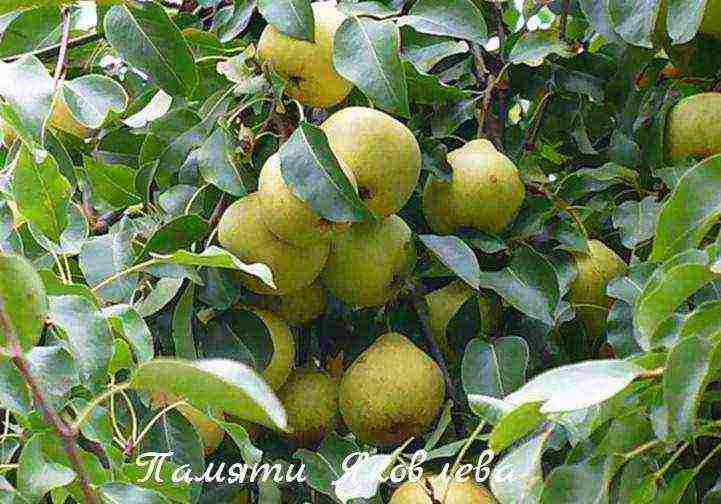
A productive variety of early autumn consumption with excellent winter hardiness. Fast growing and scab resistant.
Fruits are medium in size, broadly pear-shaped, slightly ribbed, weighing 125 grams. The skin is light yellow with a faint orange blush. There is no funnel. The saucer is narrow, of medium depth. The peduncle is long, of medium thickness, straight. The pulp is semi-oily, sweet with a little acid, with a pleasant aroma.
The pear variety in Memory of Yakovlev was included in the state register for the Russian Federation in 1985.
Pear Lyubimitsa Yakovleva: characteristic of the variety
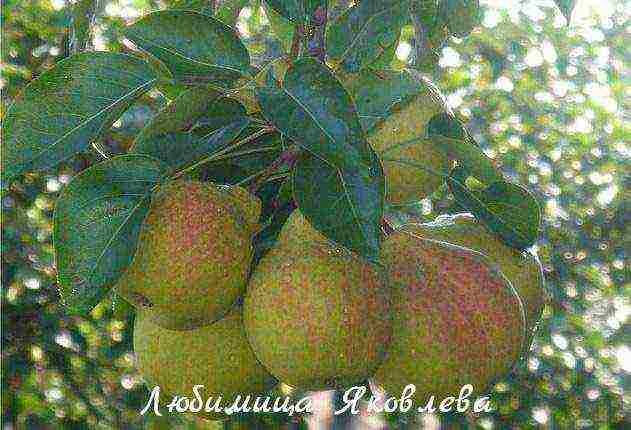
A fast-growing, table variety of pears for autumn consumption. Winter hardiness is above average. Affected by scab. The yield is average. Partially self-fertile. The crown is wide-pyramidal, thin.
Fruits are medium and above average in size, weighing 130-190 grams, rounded-rhombic or rounded-double-coconical, wide ribbed. The main color is greenish-yellow with large numerous gray subcutaneous punctures, the integumentary color is weak, blurred, dark red. The funnel is wide and shallow. The saucer is wide, shallow, ribbed. The peduncle is long, thin, straight. The pulp is coarse-grained, coarse, medium juiciness, mediocre taste.
The variety Lyubimitsa Yakovlev was included in the State Register in 1965 for the Central (Vladimir, Moscow regions), Central Chernozem (Belgorod, Lipetsk, Tambov regions), Middle Volga (Penza region) regions.
Pear Memory Zhegalov, description, reviews, photos
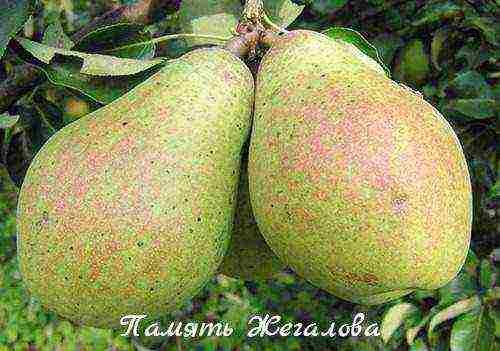
Autumn pear variety included in the State Register for the Central Region. The tree is medium-sized with a fast-growing sparse conical crown. Leaves are medium, elongated, ovate.
Fruits are regular pear-shaped, with an average weight of 120 grams, greenish or lemon-yellow at the stage of ripeness. The cover color appears in rare, well-lit fruits in the form of a slight reddish blush. The pulp is light yellow-white, very juicy, tender, melting, semi-oily, sour-sweet, slightly tart. Tasting taste assessment 4.2 points. Removable ripeness of fruits occurs in the second or third decade of September. Pears of the Pamyat Zhegalova variety are stored for up to 25-30 days. The average yield is 122 c / ha.
Pear Veles: description, photo
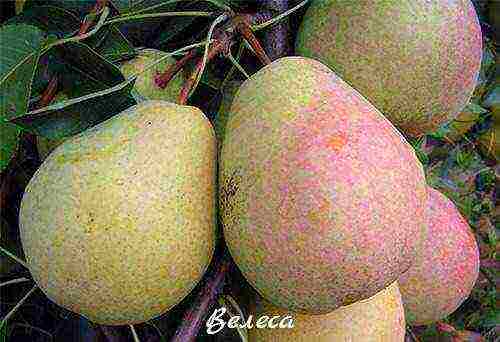
Autumn pear variety with high winter hardiness. The ovary is resistant to frost up to - 2 ° C. The tree is medium-sized with a drooping pyramidal crown. Shoots are arcuate, rounded, cherry brown, glabrous. Leaves are medium, oblong-oval, yellow-green, smooth, shiny, with delicate nerves and curved edges.
Fruits with an average weight of 120 grams, regular shape, slightly beveled. The peduncle is slightly curved. The funnel is blunt-conical. The saucer is small, wide, smooth. The color is greenish-yellow with a slight orange tan. The subcutaneous points are small, gray, subtle. The pulp is creamy, semi-oily, tender and juicy. Fruit tasting score 4.6 points.
Average yield - 126 kg / ha.
The Veles pear variety was included in the State Register for the Central Region in 2001.
Pear Faithful: description, photo
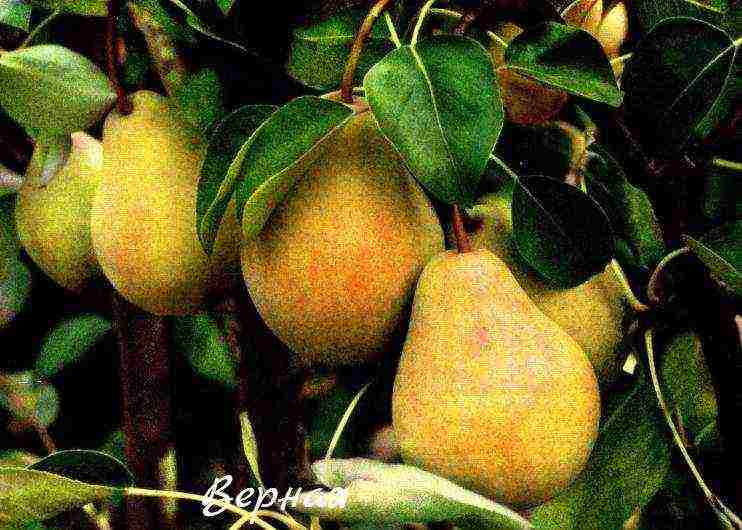
Late autumn, fruitful variety. Medium tree with drooping crown. Shoots curved, rounded, reddish-brown, glabrous. Leaves are ovoid, green, smooth.
Fruits are pear-shaped, slightly beveled, with an average weight of 100 grams. Ripening, the color is greenish-yellow with a slight tan. Subcutaneous dots are gray, hardly noticeable. The pulp is creamy, tender, semi-oily, very juicy. The taste is 4.4 points.
Winter hardiness is high, at the level of the Bessemyanka variety. The ovaries are resistant to frost up to -2 ° C.
Average yield - 232 kg / ha.
The Vernaya pear variety is included in the State Register for the Central Region of the Russian Federation.
Pear Thumbelina: variety description, photo

Autumn, winter-hardy pear variety for central Russia. The tree is medium, with a rounded crown. Shoots are round, brownish-brown, glabrous. Leaves are elliptical, green.
Fruits are small, with an average weight of 70 grams, pear-ovate. The peduncle is long, thin, erect. There is no funnel. When ripe, the color of the pears is golden yellow with a slight tan. The pulp is creamy, tender, semi-oily, very juicy. Taste 4.8 points.
Yield: 68 c / ha.
The pear variety Thumbelina was included in the State Register for the Central District in 2001.
Pear Just Maria: description, photo, reviews

Autumn variety of pears. The tree is medium-sized, fast-growing. Crohn of medium density, wide pyramidal.Leaves are medium, oblong, short-pointed.
Fruits with an average weight of 180 grams, pear-shaped. The funnel is shallow, blunt-conical. No rustiness. The calyx is not falling, open, the saucer is small, wide, smooth. The main color at the moment of removable maturity is light yellow, the integumentary color on the smaller part of the fruit in the form of a light tan, pink. In the state of consumer maturity, the main color of the fruit is light yellow, the integumentary color - on the smaller part of the fruit in the form of a light tan, blurred, pink. The pulp is yellowish-white, of medium density, tender, oily, very juicy, fine-grained, sour-sweet taste with a weak aroma. The fruits contain: sugar 8.15%, acid 0.1%, vitamin C 3.1 mg%. Tasting taste score of 4.8 points.
Average yield: 72 kg / ha (subject to agricultural technology).
The pear variety Prosto Maria was included in the State Register for the Central Region of the Russian Federation in 2003.
Winter varieties of pears with photos and descriptions Pear Belorussian late
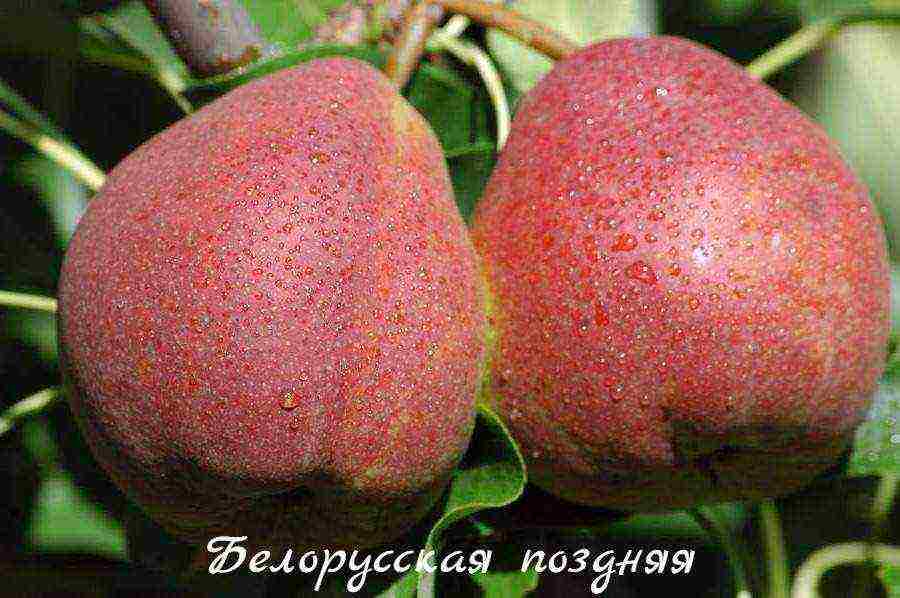
Winter variety of pears. The tree is medium-sized, with a rounded dense crown. The leaves are small, oblong, elliptical, long-pointed, light green in color.
Fruits are medium, weighing 110-120 grams, medium one-dimensionality, wide pear-shaped. The main color is orange-yellow, the integumentary color is crimson, blurred. The pulp is white, medium density, tender, oily, juicy. The taste is sweet and sour, with a light refreshing acidity. Tasting score 4.2 points. Yield: 122 c / ha.
The pear variety Belorusskaya late was included in the State Register of the Russian Federation in 2002.
If you grow any of these pear varieties or others in the Moscow region, tell me which ones do you think are the best? What do you like about your varieties? If possible, attach a photo of your crop to the comments. Thank you!
Your reviews and additions to the description will help many gardeners choose for planting the best varieties of pears.
